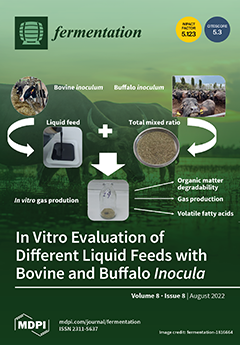The purpose of this study was to investigate the optimum proportion of sorghum straw and ammoniated wheat straw in vitro and in vivo to apply in ruminant diets. One-factor and two-factor experimental designs were used in the in vitro tests, with different ratios of sorghum straw to ammoniated wheat straw (S:AWS) of 2:8, 3:7, 4:6, 5:5, 6:4, 7:3, and 8:2 to measure the in vitro total gas production, CH
4 production, in vitro dry matter degradability (IVDMD), in vitro organic matter degradability (IVOMD) and in vitro fermentation parameters. Additionally, the nylon bag technique was used to determine the dynamic degradation of these different ratios of mixed feedstuffs for incubating in sheep rumen for 6 h, 12 h, 24 h, and 48 h. The results show that IVDMD, IVOMD, and the molar ratio of propionate were the highest when the ratio of S:AWS was 8:2 (
p < 0.05) in vitro; however, this ratio released much more CH
4 (
p < 0.05). In addition, the degradability of DM, OM, CP, and ash and the effective degradability of DM and CP were the highest when the ratio of S:AWS was 8:2 cultured in sheep rumen for 48 h (
p < 0.05). In the in vitro and in situ nylon bag tests, IVDMD, IVOMD, rumen nutrient degradability, and effective degradability of DM and CP increased with the increase in the sorghum straw proportion. In conclusion, the higher the proportion of sorghum straw, the higher the nutrient degradability in vivo and in vitro, but also the higher the emissions of CH
4. Therefore, when the ratio of S:AWS is 8:2, ruminants can effectively utilize nutrients in feed.
Full article





